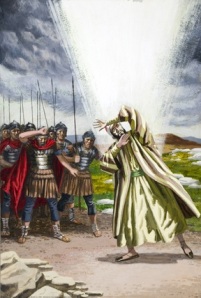Five closely related Egyptian Pharaohs shared two unusual traits – each had unusually feminized figures (large breasts and large hips), and each died young (and in fact younger than the preceding one). The former trait is suggestive of epilepsy, and the latter of a hereditary disorder. The five are Tutankhamen “the boy king”, his probable father Akhenaten, his possible uncle Smenkhkare, and before them Amenhotep III and Tuthmosis IV.
In addition, two of them had powerful sun-related religious experiences: Tuthmosis IV in the middle of a sunny day, as detailed in the Dream Stele inscription near the Sphinx in Giza; and Akhenaten, who elevated the minor sun-god Aten to be the supreme god, replacing Egyptian polytheism with what was probably the world’s first monotheist religion – the first of national significance, anyway.
Of the 40 kinds of epilepsy, the one that fits best is Temporal Lobe Epilepsy, in which seizures can be triggered by sunlight. Common symptoms include a compulsion to write, fainting, extreme religiosity, and obsessive compulsive disorder.
Akhenaten, the creator of monotheism had it. Others suspected of it include Moses, almost certainly St. Paul (who was termed epileptic by contemporaries, and whose conversion on the road to Damascus would be a classic example of such a seizure), and definitely Dostoevsky.
There has long been a recognized association between monotheism and the desert’s all-powerful sun, as there is between polytheism and the lush diversity of sun-shaded forests. And it seems that epilepsy is another component of the development and spread of the idea of the One God.
If only they’d had shades in those days, think how much grief we could have avoided!

The correlation of monotheism with desert is striking and something I hadn’t noticed.
LikeLike
Further thoughts on it here: https://robinhl.com/2011/11/05/monotheism-and-polytheism-desert-and-forest/
LikeLike
I actually suspect the correlation is with authoritarianism not monotheism, but monotheism being a fairly natural extrapolation on an authoritarian environment.
Repression tends to be tied to extreme environments, as far as I can tell. Extremely dangerous lands (Arctic, desert, highly active aggressive predators) tend towards rather repressive cultures (ones that take “conservative” to extremes). But change in those places can be high-risk and can risk a lot more than just the individual taking the chance – it can risk family, tribe and “country”.
Authoritarian leaders: I’ll use Bush W as an example of that, but one could just as easily use Xuāntǒng or Emperor Caligula. (authoritarian environment doesn’t mean powerful or insane, but either are possible, and indeed likely).
Repressive and authoritarian environments tend to produce people who AREN’T insane (by local cultural standards) as leaders – in an insane environment though. So from anyone not from there, they could seem insane. (Mahmoud Ahmadinejad might be a fairly good example here)
I’ll add – if you add stress to a repressive environment, they tend to become more repressive.
LikeLike
[…] Epilepsy and the Origins of Monotheism and The Church Of England Suggests Jesus Had Mental Problems […]
LikeLike
It’s always tough to diagnose historical figures. That said, there’s also a lot of discussion that the Apostle Paul is a good candidate for temporal lobe epilepsy (sees flash of light, falls down, don’t remember if he was “taken with the spirit” or anything like that) – but he also had what today would be called classic Geschwind Syndrome (look it up), in particular hyperreligiosity and hypergraphia. The guy wrote half the New Testament. I’d say that qualifies as hypergraphia.
LikeLike